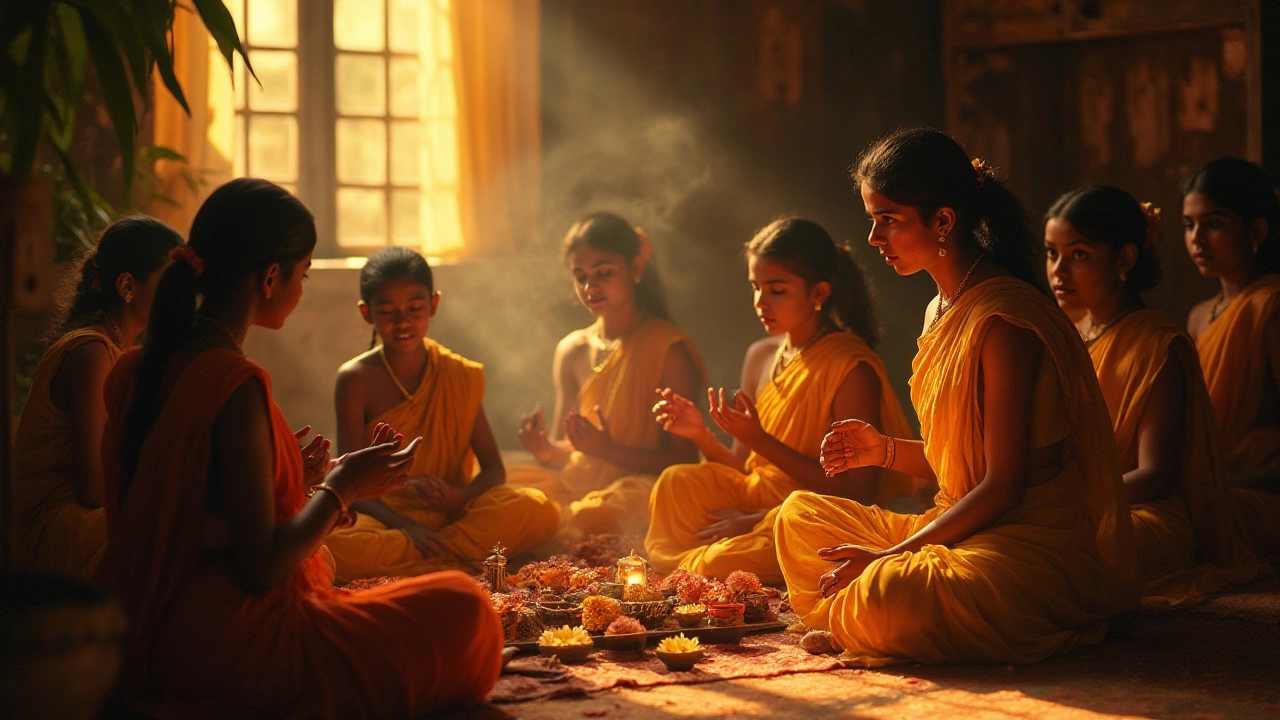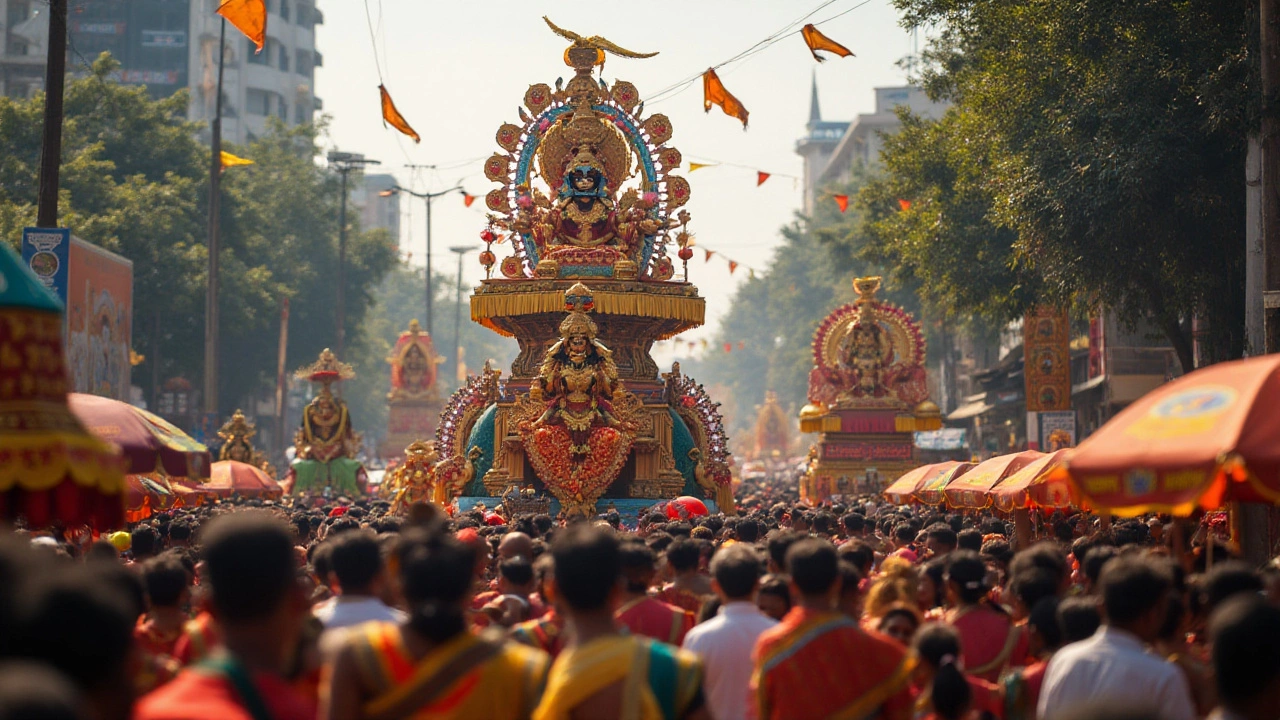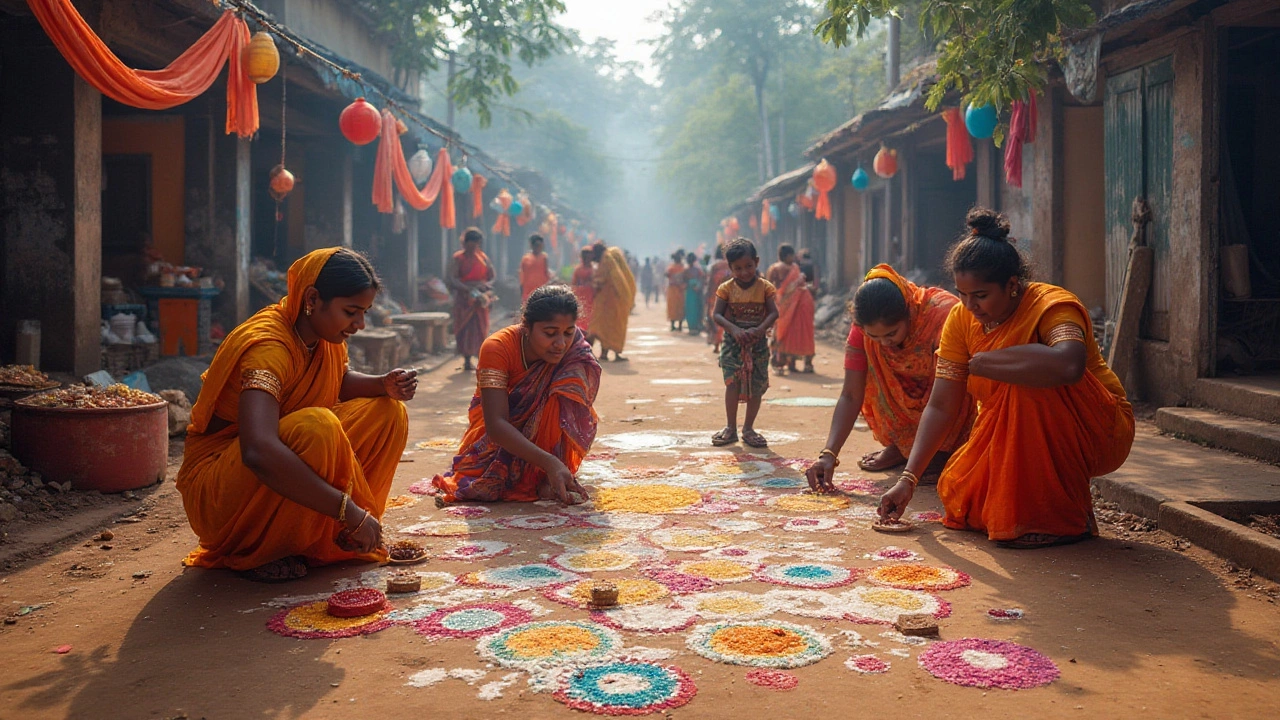The traditions of Tamil worship are as intricate and colorful as the vibrant culture itself. Centuries-old customs weave tales of devotion, reverence, and an intimate connection with the divine that shape every aspect of Tamilian life. They are not confined to mere rituals but pulsate with life in daily practices and grand festivals.
Exploring the multitude of deities revered across Tamil Nadu and beyond, one can encounter a rich tapestry of beliefs that overlap beautifully with stories of valor, love, and spiritual quests. Multiple forms of divine representations, from grand temples to small household shrines, show how spirituality is deeply ingrained in every Tamil heart.
Beyond the well-known gods like Shiva, Murugan, and Vishnu, every village worships its unique protectors and goddesses, each with its own flavor and tale. Join us in exploring these enchanting practices and see how these worship rituals continue to evolve yet remain rooted in age-old traditions.
- The Roots of Tamilian Worship
- Prominent Deities in Tamil Culture
- Regional Variations and Local Deities
- Rituals and Festivals Celebrating the Divine
- The Influence of Mythology and Folklore
- Modern-Day Practices and Adaptations
The Roots of Tamilian Worship
Delving into the roots of Tamilian worship is like leafing through the pages of an ancient book, where the ink of culture, tradition, and history blends seamlessly. The Tamil people, known for their profound spirituality, have worshipped a diverse range of gods for thousands of years. This spiritual landscape predates even some of the most ancient civilizations, with roots reaching back over 2,000 years. Religion in Tamil Nadu is inseparable from daily life, resonating through art, music, literature, and even in the way communities are structured and festivals celebrated.
The pantheon of deities the Tamils pay homage to is vast and varied, connecting modern beliefs with an ancient Dravidian past interwoven with the subsequent Vaishnavite and Shaivite influences. The Tamil Sangam literature provides glimpses into the religious life of people several centuries ago, showcasing reverence toward figures like Murugan, who is often described as the Tamil god, the son of Shiva, embodying valor and wisdom. Simultaneously, the worship of nature and animistic deities signified the indigenous layer of their spirituality before the influx of Aryan influences.
The quintessential Dravidian deities such as Mariamman, the goddess of rain, and Ayyanar, a local guardian deity, reflect an intimate tie with nature and the environment, necessities for agrarian communities throughout Tamil history. It’s intriguing to see how these deities symbolize the connection the Tamil culture has with the elements of earth, mirroring the reliance on rain and harvest cycles.
Encyclopedia of Tamil Culture and History notes, "The Tamil pantheon seamlessly absorbs new deities while preserving its ancient roots, reflecting an adaptable yet enduring spiritual fabric."
The integration of these deities with Vedic gods indicates a willingness to imbibe diverse spiritual ideologies over centuries. Temples, often at the nexus of Tamil society, played a significant role not just as centers for religious activity but as hubs for social, economic, and political interactions. Majestic temples such as the Meenakshi Amman Temple in Madurai or the Brihadeeswarar Temple in Thanjavur are not just architectural marvels; they represent the zenith of communal and devotional life across epochs.
The syncretic nature of Tamilian religious practices exemplifies an intrinsic adaptability. Despite social changes and the passage of time, these traditions have remained remarkably resilient. Today, they continue to be practiced with fervor and unity, serving as a vital thread that holds the social and cultural fabric together. Observing the vibrant practice of Tamil spirituality offers a vivid tableau of continuity, enriching the modern understanding of one of humanity's oldest living cultures.
Prominent Deities in Tamil Culture
Tamil culture boasts a vast and vivid panoply of {@keywords} that highlights how spirituality deepens community bonds. Central to Tamil spirituality are not only the major Hindu gods but also myriad local deities, reflecting unique regional practices and beliefs. Many Tamil households reserve a special altar or room as a sacred space for worship, a place where the divine presides in various forms and avatars. Tamil Nadu's temples, notable for their stunning architecture and historic significance, serve as sanctuaries connecting devotees with their gods in profound ways. From the breathtaking Brihadisvara Temple in Thanjavur to the magnificent Meenakshi Temple in Madurai, each stands as a testament to the rich spiritual legacy.
The reverence for the primary deities such as Shiva is not just worship but a lifestyle among Tamilians. Known as the destroyer and transformer within the holy trinity of Hinduism, Shiva's presence is omnipresent in Tamil art, literature, and music. Festivals such as Maha Shivaratri celebrate his being with an all-night vigil and fervent rituals. Similarly, Murugan, the Hindu god of war and victory, holds a special place, especially in regions like Palani, where thousands converge annually for the Thaipusam festival. Murugan's stories, known for their dramatic elements, echo the fierce devotion and valor admired by many Tamils.
Equally significant is the goddess Amman, often worshipped as Mariamman, known to protect against smallpox and infectious diseases. Her festivals burst with energy and devotion, as she symbolizes the nurturing and protective aspect of the divine feminine. Alongside her, Vishnu in his Krishna and Rama avatars is widely worshipped for his life affirming teachings and embodiment of dharma. Krishna's lore, with its blend of divine play and cosmic duties, resonates deeply with Tamil traditions.
Moreover, the influence of regional gods remains strong. Each Tamil village often prides itself on its own guardian deity, whose tales are passed down through oral traditions. These native deities or 'grama devatas,' like Ayyanar, often depicted riding a horse, are honored in colorful village festivals that are both communions and celebrations of faith. These festivals provide an opportunity for storytelling through dance and drama, enhancing the cultural tapestry that underscores Tamil society.
"The beauty of Tamil deities is how they embody every aspect of life, from protection and prosperity to the nurturing of nature and the universe at large," notes historian Anusha Kandasamy in her acclaimed work on religious integration in South India.
Every festival and fair becomes a rendezvous with the divine, as devotees sing praises, perform traditional dances, and offer flowers and fruits. Indicative of this devotion is the symbolic kavadi, a ceremonial act of penance performed by carrying wooden arches with offerings, often seen during the Thaipusam festival. Such gestures indicate a deep connection with age-old traditions while embracing the ever-evolving shifts of modern life.
As such, the vibrant tapestry of Tamilian worship remains a cornerstone for understanding how deeply gods and deities are interwoven with Tamil culture and traditions. Knowingly or unknowingly, these divine connections enrich the individual and collective soul, nurturing an unbreakable spiritual bond with the cosmos.

Regional Variations and Local Deities
The diversity within the Tamil culture is beautifully exemplified in the varied forms of worship and the unique deities revered across different regions. Tamil Nadu's landscapes, stretching from lush coastal areas to the rocky terrains of the Western Ghats, have fostered a multitude of local deities, each serving as a spiritual beacon for the local populace. In these regions, worship practices and deities can vary significantly, reflecting the distinct cultural and geographic influences that shape them.
One might observe that while the grand temples of Madurai and Thanjavur are dedicated to prominent gods like Shiva and Vishnu, many villages harbor fervent devotion to their own protective deities, often called 'grama devata'. These deities, sometimes lesser-known outside their immediate locales, are integral to the community's spiritual fabric. In the coastal regions, deities like Kadalamma, the sea goddess, are honored, reflecting the maritime lifestyle of their devotees. In contrast, in the agrarian belts, deities such as Mariamman, the rain goddess, receive special veneration, highlighting the reliance on agriculture.
Each village's deity holds a narrative tied deeply to the community's history and beliefs, and these stories often blend with local lore. For instance, the goddess Angala Parameswari is worshipped extensively in regions like Melmalayanur. The lore surrounding her involves both fearsome and nurturing aspects, demonstrating the dual nature of protection and punishment. Rituals associated with such deities are diverse and complex, involving colorful festivals, elaborate ceremonies, and sometimes, trance-dances that symbolize the union of the devotee's spirit with the divine.
Intriguingly, the worship of local deities often incorporates elements from multiple religions, including ancient Tamil practices, and, at times, even aspects of Jainism and Buddhism. This eclecticism highlights the Tamil people's ability to embrace various beliefs, molding them into a harmonious spiritual framework. It is not uncommon to find a shrine that houses both Hindu and Jain deities, where devotees perform rituals seamlessly integrating different traditions.
Professor Ramaswamy, a noted scholar in Tamil studies, remarks, "The strength of Tamil culture lies in its capacity for inclusiveness; whether it's in the form of language, art, or worship practices, Tamilians thrive on diversity."
The festivals dedicated to these local deities are vibrant spectacles, often reflecting ancient agricultural cycles and offering thanks for bounties. During these times, communities come alive with music, dance, and colorful processions, reinforcing communal bonds and the shared human connection to nature and the gods. Celebrating these deities is more than just ritual; it's an act of collective memory, ensuring that these traditions are passed down through generations.
In modern times, some of these regional deities have reached a broader audience, due in part to the increased mobility of the Tamil people and the spread of their cultural practices. Temples dedicated to these deities can now be found in cities outside Tamil Nadu, and in Tamil communities worldwide, illustrating how these traditions adapt and thrive even far from their original home.
Rituals and Festivals Celebrating the Divine
Rituals and festivals form the backbone of Tamil culture, offering vibrant windows into the spiritual life of Tamilians. Each ceremony is an elaborate affair, often rooted in ancient traditions that have been passed down through generations. These events serve as a venue for communal gathering, uniting families, neighbors, and entire villages in acts of devotion. Take, for instance, Pongal, the harvest festival celebrated with fervor across Tamil Nadu. People create intricate designs called kolams outside their homes, cook special dishes like the sweet rice dish also known as 'Pongal,' and express gratitude to gods for bountiful harvests. This festival is not just about thanking the divine but also about fostering community bonds and preserving heritage.
Another spectacular event is Thiruvaiyaru's Thyagaraja Aradhana, where the harmonious blend of divine devotion and classical music comes alive. Dedicated to Saint Thyagaraja, a revered composer, this festival attracts thousands of Carnatic music enthusiasts and devotees. It's a reminder of how art and spirituality are tightly woven into the Tamil daily life. As the air resonates with divine melodies, there is a sense of transcendence that connects the participants to both their ancestors and the divine realm.
"Music, in its highest form, gives soul to the universe, wings to the mind, flight to the imagination," remarked the renowned musician M. S. Subbulakshmi, highlighting the spiritual essence of such gatherings.
Every temple has its own range of rituals and festivals, many celebrating local deities unique to their region. For instance, the Aadi Perukku festival honors the eternal river Cauvery, lauding its life-giving properties. Pilgrims gather along its banks to perform rituals, float floral offerings, and partake in traditional games. It's an event that underscores the deep connection between Tamil people and their natural surroundings, embodying the very essence of living in harmony with nature. This symbiosis offers a lesson in environmental stewardship, as communities emphasize sustainable practices in their celebrations.
The grand celebration of Navaratri sees homes turning into beacons of light and devotion, as dolls and idols are arranged in beautiful steps, known as 'Golu.' With storytelling and dance performances, these nine nights ignite every household with enthusiasm and devotion. The communal aspect shines through in how families visit each other's homes to admire Golu displays, exchange sweets, and share stories and traditions. Such practices fortify social ties and facilitate cultural continuity, ensuring that the rich Tamil heritage is preserved for future generations.
The iconic festival of Deepavali, or the Festival of Lights, is perhaps the most widely celebrated. Marking the triumph of good over evil, homes are adorned with lamps and fireworks light up the sky. It isn't just a public spectacle but a personal journey for every individual who seeks to conquer their inner darkness. For many children growing up in the Tamil culture, Deepavali is an exhilarating time of new clothes, delectable sweets, and a special sense of joy and togetherness that fills their hearts with warmth and hope. The spiritual messages conveyed through rituals like these carry profound lessons in resilience, kindness, and community welfare.

The Influence of Mythology and Folklore
The tapestry of Tamil culture is not just woven with colorful threads of rituals and customs; it is richly embroidered with tales from mythology and folklore. Stories passed down through generations have helped shape the beliefs and religious practices of the Tamil people. In these tales, deities are not distant beings but intimate characters in the daily lives of the people. Mythology serves as a vehicle to teach moral values and explain natural phenomena, while folklore adds layers of cultural identity and wisdom.
At the heart of these stories lies an array of gods and goddesses, each with unique stories that highlight moral lessons and cultural values. For instance, the epic tale of Lord Murugan, a beloved deity in Tamil Nadu, is not just about his divine battles; it's also about the importance of love and family loyalty. His narrative teaches courage and strength, and his festivals bring communities together in joyous celebration.
Tamil folklore is equally vibrant, populated with magical creatures, hero figures, and wise elders. Each story has a purpose, whether it is to warn against foolishness or to inspire bravery in adversity. These stories are often accompanied by traditional music and dance, making them an immersive cultural experience. Folklore adds a dynamic charm to Tamil life, reminding us of our roots and the shared heritage that binds the community together.
Lessons from the Past
Myths and folklore also play a crucial role in environmental conservation and understanding natural phenomena. Tales about the rain god Varuna or the agricultural deity Bhumi are not just religious; they emphasize the importance of conserving water and respecting the Earth. By embedding these values within stories, Tamilians have historically ensured that such crucial lessons were remembered and practiced.
"Mythology for the Tamils is more than history; it is an essential spiritual and moral guide," states Dr. Narayana Iyer, a prominent historian on South Indian culture.In essence, the influence of mythology and folklore is profound and pervasive, touching on every aspect of life. They provide a lens through which the Tamils view their world, their society, and themselves. Cultivating and passing down these stories isn't merely tradition; it's preserving the soul of Tamil culture.
Modern-Day Practices and Adaptations
The contemporary Tamil society, while holding on tight to age-old traditions, has skillfully interwoven these with the fabric of modern life, leading to unique practices that resonate with today's youth yet maintain their cultural significance. For many younger Tamilians, worship is more than just tradition; it's an opportunity to reconnect with their roots amidst the rapid pace of life. Technologies like virtual temple visits and online puja services have become prevalent, providing a digital spiritual experience for those living abroad or bound by time constraints. It’s fascinating to witness how tech-savvy Tamilians have adapted age-old traditions to the digital era, creating spaces where physical presence is no longer a necessity to feel spiritually connected.
One of the most visible shifts has been in the way festivals are celebrated among diaspora communities. These events have grown into multifaceted celebrations, incorporating both traditional activities and contemporary entertainment. They're no longer confined to religious contexts but have become venues for cultural exchange, showcasing dance, music, and the culinary arts of the Tamil regions. For instance, the grand celebration of Pongal among Tamil communities abroad attracts not only Tamilians but people from various backgrounds, eager to experience and understand this vibrant culture firsthand. Such modern adaptations promote cross-cultural understanding while keeping the rich heritage alive.
Another fascinating adaptation is the increasing involvement of women in religious practices, stepping into roles traditionally reserved for men. This shift is significant in urban centers where professional opportunities have opened new paths for women to take on leadership roles, including orchestration and participation in temple administration and event management. This marks a progressive shift where devotion and spirituality take precedence over historically gendered religious roles, reflecting a broader global movement towards gender equality.
In many urban homes, individual altars have taken on a minimalist and modern look, without the traditional clutter but with the same spiritual essence. It's common to see a blend of influences in these spaces, with deities from different parts of the world adorning a Tamil home shrine, symbolizing the inclusive and adaptable nature of Tamil spirituality. As much as these changes reflect a departure from traditional depictions, they represent an enduring faith repurposed to fit the lifestyles of today.
Tamil culture, known for its ability to blend the new with the old, continues to inspire a sense of pride and belonging. As communities spread across the globe, they're not just preserving their beliefs but evolving them. A quote from the renowned Tamil historian Bala Swaminathan encapsulates this beautifully:
"The essence of Tamil culture isn't just in preserving our gods and rituals but in living them, regardless of where we plant our roots."This dynamic adaptability ensures that Tamilian worship remains not just a cultural relic but a living, breathing tradition, ready to meet the future head-on.
